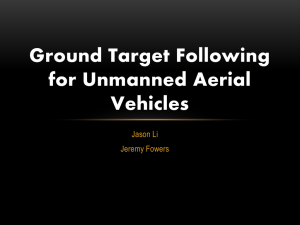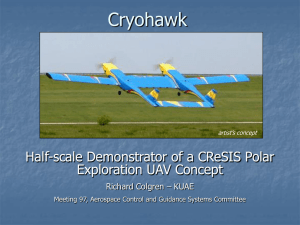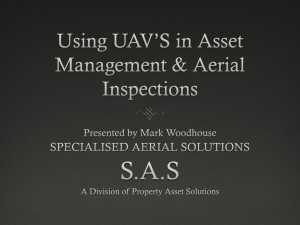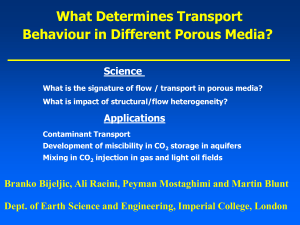Flight Operations Manual
advertisement
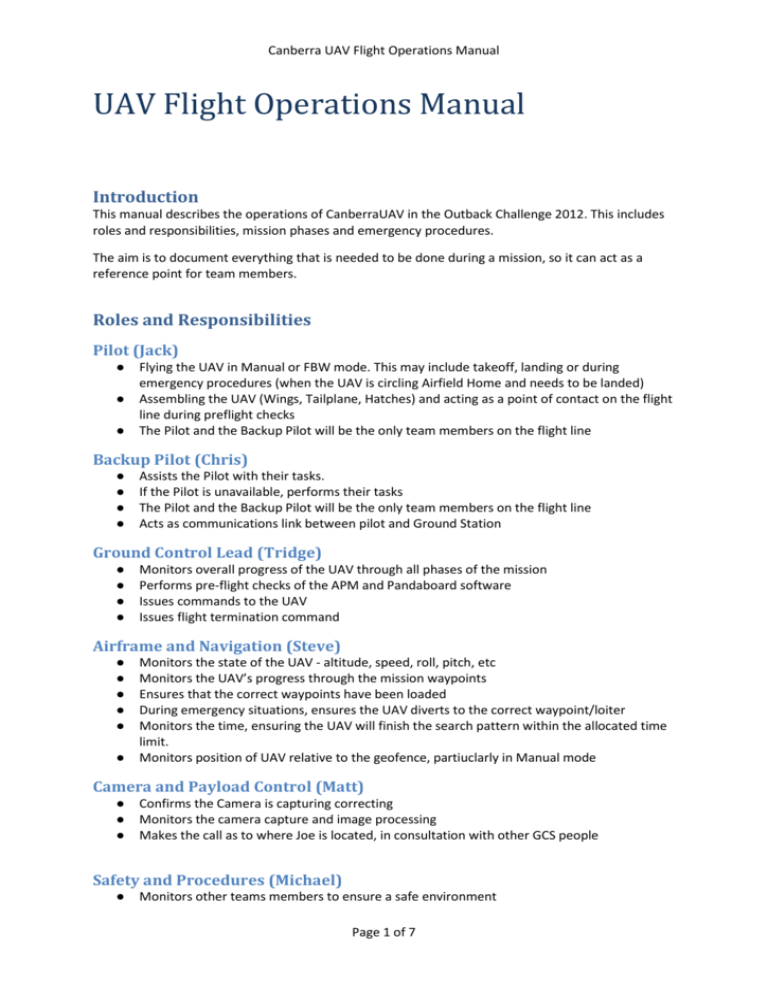
Canberra UAV Flight Operations Manual UAV Flight Operations Manual Introduction This manual describes the operations of CanberraUAV in the Outback Challenge 2012. This includes roles and responsibilities, mission phases and emergency procedures. The aim is to document everything that is needed to be done during a mission, so it can act as a reference point for team members. Roles and Responsibilities Pilot (Jack) ● ● ● Flying the UAV in Manual or FBW mode. This may include takeoff, landing or during emergency procedures (when the UAV is circling Airfield Home and needs to be landed) Assembling the UAV (Wings, Tailplane, Hatches) and acting as a point of contact on the flight line during preflight checks The Pilot and the Backup Pilot will be the only team members on the flight line Backup Pilot (Chris) ● ● ● ● Assists the Pilot with their tasks. If the Pilot is unavailable, performs their tasks The Pilot and the Backup Pilot will be the only team members on the flight line Acts as communications link between pilot and Ground Station Ground Control Lead (Tridge) ● ● ● ● Monitors overall progress of the UAV through all phases of the mission Performs pre-flight checks of the APM and Pandaboard software Issues commands to the UAV Issues flight termination command Airframe and Navigation (Steve) ● ● ● ● ● ● Monitors the state of the UAV - altitude, speed, roll, pitch, etc Monitors the UAV’s progress through the mission waypoints Ensures that the correct waypoints have been loaded During emergency situations, ensures the UAV diverts to the correct waypoint/loiter Monitors the time, ensuring the UAV will finish the search pattern within the allocated time limit. Monitors position of UAV relative to the geofence, partiuclarly in Manual mode Camera and Payload Control (Matt) ● ● ● Confirms the Camera is capturing correcting Monitors the camera capture and image processing Makes the call as to where Joe is located, in consultation with other GCS people Safety and Procedures (Michael) ● Monitors other teams members to ensure a safe environment Page 1 of 7 Canberra UAV Flight Operations Manual ● ● ● ● ● ● ● ENsures team is following the Procedures and Operations Manual Acts as the interface between the Judges and Ground Control - keeps the Judges informed as to our progress and status. Gives Joe position the Judges and recieves bottle drop confirmations from them Holds the radio link to the pilot Provides antenna pointing direcitons Organises NMEA cable Coordinating with Judges during failsafe situations 1 ● Points the GCS antenna towards the Mugin 1 ● Antenna Pointer (Paul) RF links (Ron) Monitors the RF Link Quality Setup Assembling the Mugin (The night before) ● ● ● ● ● ● ● ● ● ● Assemble Wings and Tail Check for physical damage Check all electronics present and connected Check for working flight surfaces Confirm all batteries charged No physical damage to airframe, engine, propeller or avionics All hatches closed and secured on aircraft Area and runway clear of unnecessary personnel and debris Confirm SLA and engine ignition batteries charged Confirm fuel tank full Setup of the Ground Station (The morning of) ● ● ● ● Radio links active and working (with a decent SNR value) All laptops (x4 plus TV) working and networked All laptops sotware working correctly All Ground Station operators confirm Pre-startup checks ● ● ● ● ● ● ● Verify ○ All servos and flight control surfaces responsive ○ APM(s) running ○ Pandaboard running ○ RC radio link working Confirm GPS Lock COnfirm compass enabled, COMPASS_USE=1 Confirm Altitude lock Ensure flight mode MANUAL Airspeed calibration and check Reciever failsafe check Page 2 of 7 Canberra UAV Flight Operations Manual ● Check barometric pressure sensor calibration Post-startup Checks ● ● ● ● ● Engine running nominally Ensure flight mode MANUAL Confirm IMU gives the correct orientation Double check barometric sensor is showing 0m altitude The APM's current waypoint should be set to 0 Flight Phases Takeoff and cruise to search area (0:00 - 5:00) ● ● ● ● ● ● Takeoff may be automatic or manual, depending on weather conditions and how confident we are feeling. ○ For automatic takeoff, the pilot switches to AUTO via left swtich and then right switch (can't go via FBWA mode). GCS types wp set 3. The UAV then takes off ○ For manual takeoff, allow the pilot to set to Manual mode. After takeoff and when the UAV is at least 30m off the ground, switch to FBWA mode. One the UAV has stable flight, the pilot switches to AUTO. The UAV should reach a target altitude of 90m AGL in approx 25 seconds. Once the UAV is in stable AUTO flight, the GCS will disable stick mixing (rudder control) Before the UAV is outside RC control range, the pilot will switch off the RC transmitter The pilot will stand watch the UAV until it is out of visual range. Note the distance at witch the UAV is out of sight. While the UAV is tracking to EL1, ensure that: ○ The UAV manoeuvres correctly (good parameters) ○ GPS has a solid lock (can we check for a signal strength / # of satellites locked?) ○ SNR on both radios is acceptable ○ Camera is showing good quality images ○ If needed, switch off USE_COMPASS Searching for Joe (5:00 - 35:00) ● ● ● The Radio link will be stretched to it’s limits during this section. Keep a very close eye on it If the Camera operator(s) are confident that Joe has been found part-way through the mission, we may decide to abort the search pattern and go directly for the bottle drop (with the organiser’s permission) The Mission Planner should keep a monitor on any potential geofence breaches Joe Detected (35:00 – 40:00) ● ● ● ● ● If there is sufficient time, a confirmation pass over Joe would result in a better georeference. Do this by moving one of the search line to over Joe's poisition and doing a wp set X. As soon as we decide to tell the organisers where we think Joe is, the mission planner should immediately be setting up the 2 bottle drop waypoints, accounting for wind speed and direction. We want to be flying into the wind THere are 2 bottle drop points (wp 21 and 22). WP21 should be about 400m downwind of Joe (or less if the geofence is near) if possible. Make sure the altitude of these points is 90m AGL the Joe point. While we wait for the organisers confimration, the UAV should continue the search pattern. If it finishes the pattern, it should loiter in the middle of the search area. Page 3 of 7 Canberra UAV Flight Operations Manual Bottle Drop (40:00 - 45:00) ● ● ● ● The Mission planner will order a waypoint jump to the bottle jump points. wp set 21 The Mission Planner will count down time to bottle drop The UAV will confirm the bottle drop mechanism activation The UAV will then track to the exit lanes EL3 and EL4 Return to Airfield (45:00 - 50:00) ● ● ● Keep a general eye on the UAV - tracking to airfield, etc Communicate with the Judges about the estimated time of landing and time of landing The Judges may want us to hold short of the runway to make room for oether aircraft Landing (50:00 - 55:00) ● ● Landing may be automatic or manual, depending on weather conditions and how confident we are feeling. By defualt it will automatically land ○ In automated mode, the GCS will keep a careful eye on the speed and altitude of the UAV ○ The pilot will confirm when the UAV is in visual range ○ The pilot will switch of the RC transmitter when they are confident of Manual control. They should ensure the Transmiiter is set to the right modes/switches before power-on. THe GCS should be infomred when this happens ○ If, at any point during the landing, we are not confident in the auto landing the pilot will manually take over (only if the UAV is in visual range though) ○ During a manual landing, the GCS will call out the airspeed and altitude for the pilot via the 2-way radios Emergency Procedures Loss of Datalink ● ● ● ● ● Occurs if the both datalinks are lost (no heartbeat) for more than 10 seconds ○ If combined with a loss of GPS, the UAV must terminate ○ The the RC link fails during manual flight, the UAV must terminate The UAV will fly to the Comms Hold waypoint and loiter to 2 minutes The UAV will fly to the Airfield Home waypoint and loiter to 2 minutes If the datalink is not re-established in this time, the UAV will terminate We are allowed a maximum of 2 datalink losses (“no heartbeat”) during the mission Loss of GPS ● ● ● ● ● If the GPS reports a loss of lock, this mode must be activated immediately The UAV will automatically loiter around the point of GPS lock loss (via dead reckoning) for 30 seconds. Loiter radius is ~100m The UAV will navigate to the Airfield Home waypoint (via dead reckoning) RC control will be established and the UAV landed, otherwise flight termination We are allowed a maximum of 1 GPS loss during the mission APM Software crash (Failure of Autopilot software / Failure of SAS) ● ● If no heartbeat is heard from the APM for more than 1 second, this mode is activated Flight termination must be immediately activated Loss of engine power ● If the UAV's airspeed and altitude drop, the engine has most likely stopped Page 4 of 7 Canberra UAV Flight Operations Manual ● The GCS will do wp set AF_HOME and the UAV will attempt to glide to airfield home. Geofence breach ● If the Fence is breached, flight termination will be immediately activated GCS Software failure ● ● ● If the main GCS laptop AND the both radio links fail for more than 10 seconds, this mode is entered into If hardware failure, the secondary GCS laptop will change it's IP and MAC address the primary and take over (via 5.8 GHz). Run the supplied scrpt to take over Same as loss of datalink mode Commanded Destruction ● THe command the initiate destruction is 'param set FS_TERMINATE 1' Annexes Waypoint ID’s ID# Name 0 Airfield Home 1 Jump to Entry Lane 1 (24) 2 Jump Dummy 3 Takeoff 4 Jump to Entry Lane 1 (24) 5 Jump Dummy 6 Landing approach 7 Change to 22 m/s 8 Landing approach 2 9 Change to 18 m/s 10 Landing 11 landing dummy 12 Comms Failure 13 Loiter 2 minutes 14 Airfield home Comments Mission starts here (after manual takeoff) Mission starts here (auto takeoff) Begin landing sequence End of landing sequence (and mission) Begin Datalink Failure - go to Comms Hold point Page 5 of 7 Canberra UAV Flight Operations Manual 15 Loiter 2 minutes Failsafe activated after this point 16 GPS fail - loiter 30 secs Begin GPS failure 17 Airfield home 18 Loiter (no time limit) Failsafe activated after this point 19 Joe approach Begin Joe Drop 20 Joe Drop location 21 Drop bottle 22 Jump to exit lane (28) 23 jump dummy 24 Entry Lane 1 25 Entry Lane 2 26 Jump to search mission (26) 27 jump dummy 28 Exit Lane 1 29 Exit Lane 2 30 Jump to landing approach (6) 31 jump dummy 32 Search 1 Begin search 110 Search 79 End search 111 Loiter in search area for 10 minutes At some point during this time, goto the Joe drop (19) 112 Jump to exit lane (28) 113 jump dummy End Joe Drop ... Mugin Performance Info Specification Value Maximum Airspeed 100 kts (180 Km/h) Page 6 of 7 Canberra UAV Flight Operations Manual Cruise Airspeed 50 kts (90 Km/h) Endurance at maximum airspeed Estimated 30 minutes Endurance at cruise airspeed 80 minutes Maximum take off weight 22 Kg Competition take off weight 18 Kg Wingspan 3m Airframe length 2.5 m Identifying marks “08WA” on side of fuselage Aircraft planform and configuration Twin boom V-tail pusher aircraft Page 7 of 7

